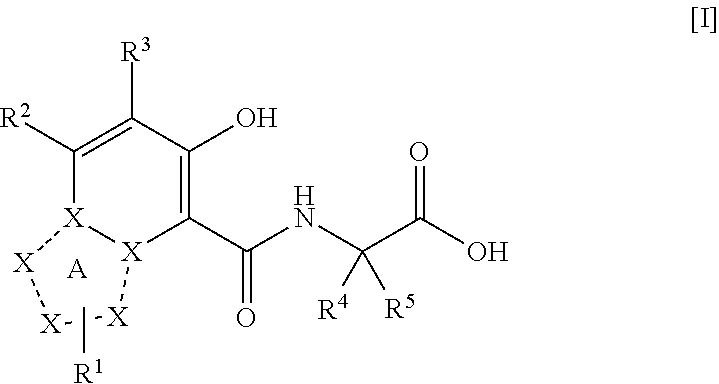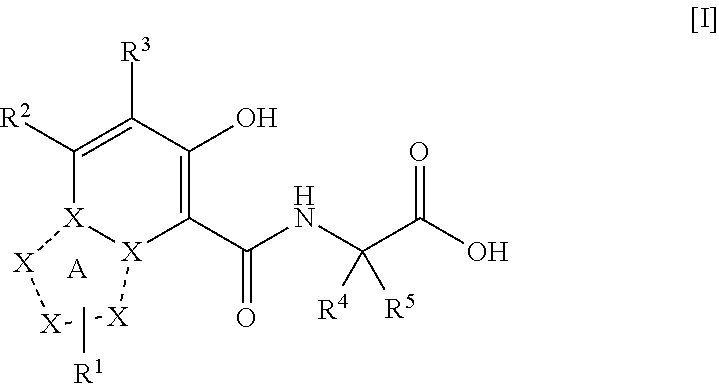Triazolopyridine compound, and action thereof as prolyl hydroxylase inhibitor or erythropoietin production-inducing agent
a technology of erythropoietin and triazolopyridine, which is applied in the field of new drugs, can solve the problems of short half-life in blood, high cost, and spreading of drugs, and achieve the effect of reducing the production of epo and promoting the production of erythropoietin
- Summary
- Abstract
- Description
- Claims
- Application Information
AI Technical Summary
Benefits of technology
Problems solved by technology
Method used
Image
Examples
example 1
Production of {[5-(4-fluoro-3-trifluoromethylphenyl)-7-hydroxy[1,2,4]triazolo[1,5-a]pyridine-8-carbonyl]amino}acetic acid hydrochloride
Step 1-1
[0284]
[0285]Under a nitrogen stream, diisopropylamine (198 ml) and tetrahydrofuran (1000 ml) were mixed, and n-butyllithium (2.76M, 500 ml) was added dropwise under cooling in dry ice / hexane bath. After stirring in the dry ice / hexane bath for 1 hr, 2,4-dichloropyridine was added dropwise. After stirring under cooling in the dry ice / hexane bath for 1 hr, carbon dioxide was blown until the temperature rise ceased while preventing a temperature of not less than −60° C. Carbon dioxide was further blown for 30 min under cooling in the dry ice / hexane bath, and 4N hydrochloric acid (1000 ml) was added dropwise. The aqueous layer was extracted twice with ethyl acetate (each 1000 ml, 500 ml). The organic layers were combined, dried over sodium sulfate, filtered, and concentrated under reduced pressure. The obtained solid was slurried in hexane to give...
example 2
Production of [(7-hydroxy-5-phenethyl[1,2,4]triazolo[1,5-a]pyridine-8-carbonyl)amino]acetic acid hydrochloride
Step 2-1
[0322]
[0323]The compound (5.00 g) obtained in step 1-7, toluene (35 ml) and phenylacetylene (1.34 ml) were mixed, and bis(triphenylphosphine)palladium dichloride (0.233 g), copper iodide (0.063 g) and triethylamine (1.85 ml) were successively added under ice-cooling. After stirring at room temperature for 2 hr, 5% aqueous ammonia (35 ml) was added to the reaction mixture. The organic layer was further washed successively with 5% aqueous ammonia, saturated aqueous ammonium chloride solution and saturated brine, and dried over anhydrous magnesium sulfate. After filtration, the filtrate was concentrated under reduced pressure, and the obtained residue was purified by column chromatography (eluent: hexane / ethyl acetate=3 / 1-1 / 1). The obtained compound was slurried in hexane to give the compound described in the above-mentioned scheme (3.84 g, 82%).
[0324]1H-NMR (DMSO-D6) δ...
example 3
Production of [(5-butyl-7-hydroxy[1,2,4]triazolo[1,5-a]pyridine-8-carbonyl)amino]acetic acid hydrochloride
Step 3-1
[0340]
[0341]The compound (0.2 g) obtained in step 1-7, [1,1′-bis(diphenylphosphino)ferrocene]palladium(II) dichloride dichloromethane complex (1:1) (0.011 g), butylboronic acid (0.050 g), silver(I) oxide (0.12 g), potassium carbonate (0.15 g) and tetrahydrofuran (1.6 ml) were mixed, and the mixture was stirred at 80° C. for 40 hr. Insoluble material was filtered off, and the filtrate was concentrated under reduced pressure. The residue was purified by column chromatography (eluent: hexane / ethyl acetate=8 / 2-6 / 4) to give the compound described in the above-mentioned scheme (0.13 g, 77%).
[0342]1H-NMR (DMSO-D6) δ: 0.91 (t, 3H, J=7.7 Hz), 1.28-1.39 (m, 2H), 1.48 (s, 9H), 1.71-1.81 (m, 2H), 3.11 (t, 2H, J=7.7 Hz), 5.38 (s, 2H), 7.23 (s, 1H), 7.32-7.51 (m, 5H), 8.39 (s, 1H).
Step 3-2
[0343]
[0344]The carboxyl-protecting group of the compound (53.7 g) obtained in step 3-1 was remov...
PUM
| Property | Measurement | Unit |
|---|---|---|
| carbon number | aaaaa | aaaaa |
| carbon number | aaaaa | aaaaa |
| carbon number | aaaaa | aaaaa |
Abstract
Description
Claims
Application Information
 Login to View More
Login to View More - R&D
- Intellectual Property
- Life Sciences
- Materials
- Tech Scout
- Unparalleled Data Quality
- Higher Quality Content
- 60% Fewer Hallucinations
Browse by: Latest US Patents, China's latest patents, Technical Efficacy Thesaurus, Application Domain, Technology Topic, Popular Technical Reports.
© 2025 PatSnap. All rights reserved.Legal|Privacy policy|Modern Slavery Act Transparency Statement|Sitemap|About US| Contact US: help@patsnap.com



